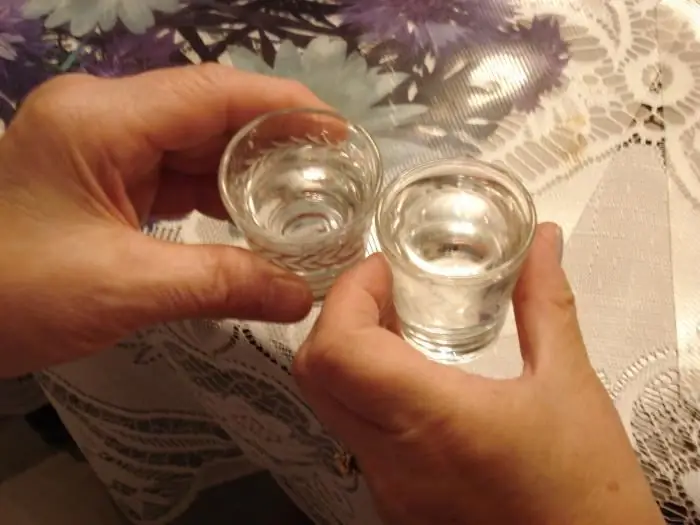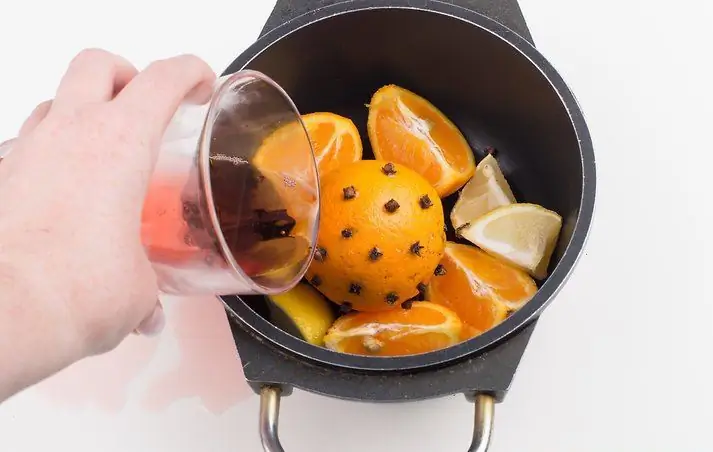2025 Author: Isabella Gilson | [email protected]. Last modified: 2025-01-23 12:50:43
Plum wine is a specific alcoholic drink with an unusual aromatic bouquet. An amateur, but many people like it. The semi-dry version goes well with meat dishes, and the sweet wine sounds good with desserts. How to cook it at home? It's not very difficult, actually, that's what we'll talk about now.

Subtleties
First of all, you need to make a reservation that fruits of any variety are suitable for making plum wine, but it is better to opt for dark ones. And, of course, they must be ripe. If a person himself decided to collect the fruits, then you need to pluck only those that have ripened so much that they themselves begin to break away from the branch.
Before cooking, it is recommended to put the fruit in the sun for several hours. But you don't need to wash them, unless there is dirt stuck to them.
Many are afraid to choose the wrong variety because of the sweetness. Indeed, there are very sugary plums. But don't worry - the sugar contenteasily adjustable during cooking.
The main difficulty is getting the juice. After all, plums have a high content of pectin, which makes their pulp jelly-like. That is why there is no pure juice of these fruits on sale - only nectar.
But plums have a very high glucose content. So you need to make less white sugar. Yes, and fermentation is more intense.

Ingredients
To make plum wine at home you will need:
- Plum fruits - 10 kilograms.
- Water. One liter per kilogram of plum pulp.
- Sugar. The amount depends on how sweet the wine the person wants to get in the end. The minimum proportion is 100 grams per liter of juice, and the maximum is 350 g.
As already mentioned, the "requirements" for fruit are low. The only thing is that you need to immediately throw out moldy, rotten and spoiled fruits. Even the pulp from one bad plum can spoil the whole wine. Therefore, you will have to sort out the fruits carefully.

Getting juice
This is the first step. First, from unwashed plums wiped with a towel, it is necessary to remove the bones. Then carefully crush the pulp to get a homogeneous mixture. In appearance, the mass should resemble mashed potatoes.
Then you need to add water and mix thoroughly. As already mentioned, the proportions are respected in the ratio 1:1.
The resulting juice should be sent to some dark place for two days,where the temperature ranges from 18°C to 25°C. Be sure to cover the container with gauze folded in several layers. This will keep the must from getting flies.
Every 6-8 hours you will need to stir the puree diluted with water. It is recommended to use a clean wooden stick. At each time, you need to immerse the pulp in the liquid - the surfaced layer of pulp and peel. When 48 hours have passed, this mass will separate from the juice.
It will not be possible not to notice this process, as it is accompanied by the appearance of foam and bubbles on the surface. This indicates that fermentation has begun. What to do? Strain the wort! We need to get rid of the pulp. It's easy - you just need to pour the contents into another container through cheesecloth or a fine mesh.
Juice should fill 3/4 of the vessel, no more. It's important to leave space. After all, fermentation is accompanied by the release of carbon dioxide and foam, and they need a place.

Fermentation
The next step in making homemade plum wine. After pouring the juice into the fermentation vessel, you will need to add sugar to the liquid. What quantity? It depends on the initial sweetness of the fruit and the type of wine you want to get. Here are the approximate proportions (the amount of sugar is indicated per 1 liter of juice):
- Dry wine - 100g
- Semi-dry - 250g
- Semi-sweet - 200g
- Sweet - 350g
You can't add all the sugar at once. First - 50% of the total volume, immediately after pouring the juice into a vessel. It will take a long time andmix thoroughly to dissolve it. It will take a long time, because sugar is difficult to break down in an already sweet liquid.
Then you will need to install a water seal on the container. The simplest option is a rubber glove with a tiny hole in the finger made with a needle.
And yes, plum wine should ferment in a dark room with a temperature of 18-26 °C.
How do I add the remaining sugar?
Important question. When writing a recipe for homemade plum wine, you can’t help but give an answer.
The remaining sugar must be added to the container four times, an equal amount every 5 days. You need to do it like this:
- First remove the glove.
- Pour a small amount of juice through a straw into another container. The amount of sugar added should be twice the volume of the liquid.
- Stir thoroughly.
- Pour syrup back into fermenting plum wine.
- Return the water seal.
In order not to forget how many more times to add sugar, it is recommended to make serifs on the container.

Timing
According to this simple recipe, plum wine should ferment for 60 days at home. But the completeness of the process can be determined by the deflated glove. The fact that it "sank" means one thing - the gas has ceased to be released. By the way, a characteristic sediment will appear at the bottom.
What should be the next step? Young wine is poured into another clean container. There it will ripen.
By the way, you can try the drinkbefore that. If it seems not sweet enough, you can add a little more sugar. Some "fix" the wine by adding 40-45% alcohol or vodka. But the main thing here is not to overdo it. Permissible maximum strong alcohol - 15% of the total volume of wine. And it is also worth considering that the drink will acquire a harsh taste.
It is important to note that fermentation sometimes lasts longer than 55 days. Then there may be bitterness. To avoid this, it is necessary to drain the wine from the sediment into another vessel. The water seal can be used the same.

Ripening
It will take a long time for the plum wine to clear. At least 2-3 months. Particles are almost impossible to quickly filter, so the only sure way out is to wait.
Containers that need to be filled to the brim with a young drink are hermetically sealed. If sugar was added for more sweetness, then the first week you need to hold it under a water seal.
Then the closed containers are transferred to where the light does not pass. And the temperature there should be between 6 °C and 16 °C. A fridge or basement will do.
Every 15-20 days you will need to filter the drink from the sediment. Just slowly pour it into another vessel. Without touching the draft, of course.
Plum wine made according to this recipe at home is drunk quickly. But it is highly recommended to keep at least a couple of bottles for 2-3 years, filtering regularly. Every connoisseur of good alcohol is simply obliged to try real wine made from plums with his own hands.
This does not require every2-3 weeks to carry out this procedure. Once every 2 months is enough. However, full transparency will still not be achieved. All because of the peculiarities of plums. But this does not affect the excellent multifaceted taste.
Recommended:
What is the difference between a wine drink and wine? Carbonated wine drink

How is a wine drink different from a traditional wine? This question interests many people. That is why we decided to answer it in the presented article
Bread wine. What is the difference between vodka and bread wine? Bread wine at home

For many modern Russians, and even more so for foreigners, the word "polugar" means nothing. That is why some take the name of this revived drink as a marketing ploy, because every six months some new strong alcoholic drinks appear on the shelves
How to make mulled wine at home? Spices for mulled wine. Which wine is best for mulled wine

Mulled wine is an alcoholic warming drink. It is served in winter in all reputable establishments. But to enjoy this drink, it is not necessary to go to a restaurant. You can easily cook it yourself. How to cook mulled wine at home will be discussed in detail in the article
Wines for mulled wine. What kind of wine is needed for mulled wine?

As for the base - wine for mulled wine, the classic version is red, made from dessert and table grapes. For the fortress, an intoxicant is added: suitable liqueurs, cognacs, rum. However, you can't go overboard with them. After all, the task of the drink is to pleasantly relax a person, fill the body with warmth, cheer up, improve well-being
Homemade plum wine: a simple recipe

The summer season will start very soon. Many will go to their plots to plant the next crop, and in the fall the question will definitely arise: what to do with the surplus of this very crop. For those who love plums, there is great news: you can make a great, light fruity wine from plums that will remind you of summer days for a long time to come

